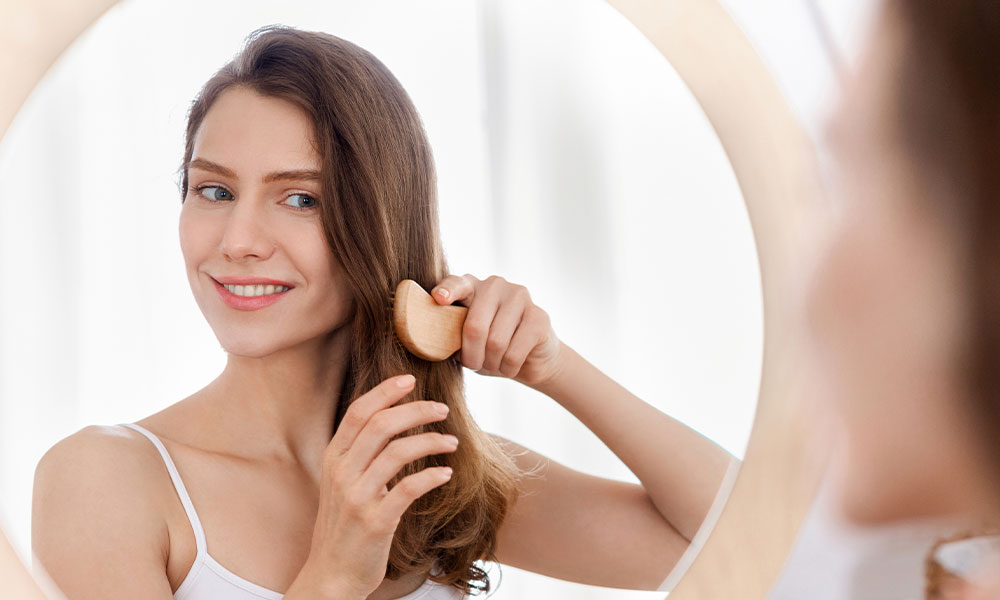
At this time of the year, as many of you will have already noticed, the change of season can affect your hair and skin. And it’s normal for your skin to become drier and your hair to fall out more easily when temperatures drop.
Would you like to know more about why this happens and what you can do to fix it? Then don’t miss the next post:
Why does hair fall out in autumn
Before delving into the subject, we would like to stress that hair loss is nothing to be alarmed about when it’s caused by a change in season. Nevertheless, when this happens in large quantities or it’s not due to a change in season, it’s advisable to consult a specialist who can better understand the underlying cause of the problem. Having clarified this point, let’s talk about why hair usually falls out in autumn.
Well, if we stop to analyze it, people are not the only ones who suffer this change—animals also shed their coats and this doesn’t alarm us; the process is the same and in both cases, it’s natural.
Environmental factors and personal habits
The fact is, once autumn arrives, there’s one factor that changes drastically: the hours of sunlight in a day, and consequently, the hours of light we receive. This directly affects our production of melatonin, a hormone involved in the stages of hair growth.
Added to this are two conditions influenced by our habits in each season. On one hand, in summer-the season we have just left behind— we must have spent several weeks badly treating our hair, due to high sun exposure without using sunscreen on our scalps, washing our hair more often than recommended or constantly exposing it to chlorine and sea water. And on the other, we have entered a season where, due to the cold weather, we go back to using heating appliances, such as driers or hair straighteners, that will end up weakening hair and causing breakage.
Well, to this accumulation of habits and environmental conditions, we must add one final factor: stress. Something that can easily happen, as we are facing a return to routine after some months of disconnection. Hair loss caused by these factors is called telogen effluvium, characterized by hair falling out in locks while shampooing or combing.
It sounds like the perfect cocktail for hair loss, right? But let’s not panic, because hair may have its cycles, but we also have our hacks and knowledge to reach a balance and to mitigate the consequences of these factors.
How to prevent hair loss
For our bodies to respond well, we must take the best care possible. This means not only using products suitable for our needs, but also leading a healthy lifestyle, and this is where we’re going to start.
Adequate diet
There are many vitamins that influence hair growth and that we can incorporate through proper nutrition, but while always maintaining a balanced and varied diet. Biotin for example, present in eggs, is one of them, but so are iron, zinc, calcium, folic acid, phosphorus and even water. Including these nutrients in our diet will be part of the change needed to improve hair health.
Products to prevent hair loss and breakage
In addition, we can use products that are specifically recommended to stop hair loss, such as our Shampoo with Caffeine, which prevents hair loss from the follicle and helps to curb the appearance of dandruff—another phenomenon that can be aggravated in autumn, as the skin and scalp become dry, thus leading to the formation of small light white flakes, i.e., dandruff.
This product improves hair hydration, as it contains Piroctone Olamine and Caffeine, two ingredients that hydrate the scalp, reducing dryness, eliminating dandruff and preventing hair loss. And the fact is, caffeine has become a popular active ingredient used in preventing hair loss, as it encourages the activation of the hair bulb and its growth.
To boot, as we mentioned above, your hair is coming out of a period in which it’s been treated quite badly due to the environmental conditions it’s been exposed to during the summer. What do we recommend? Combining the use of an anti-hair-loss shampoo with a repairing mask to prevent hair splitting, which is a form of hair loss that doesn’t occur in the follicle.
Another option is our Onion Shampoo—onion extract has growth-stimulating sulfur, phenolic and flavonoid compounds. Furthermore, it has antioxidant and anti-irritant properties and protects hair color.
For better results, we advise you apply on damp hair, massage in and rinse thoroughly with water. Wash a second time, leave it in to act for a while and rinse again.
Complete your wash with our Onion Hair Mask or Olive Oil Untangling Mask. Both help to hydrate and protect your hair.
Last but not least in terms of what products to use to protect your hair, we want to talk to you about the use of Heat Protectants. One of the main causes of hair and volume loss is the frequent use of heat products without protection.
It’s very important, therefore, to introduce this step before drying hair with a dryer—a habit we resume in autumn—using straighteners, wands or any other heated styling tool. In this case we recommend Defense, a Heat Protectant with anti-frizz action, multivitamins and minerals, protecting against heat of up to 230º.
Showers at a non-aggressive temperature
And to finish, another good thing for both your skin and hair is avoiding excessively hot showers. We know it’s tempting due to the cold seeping into our homes now, but it’s not ideal for your skin, as water that’s too hot causes dehydration, stripping the skin, and scalp, of essential oils.
That’s all for today’s post! We hope we’ve helped you to deal with this seasonal problem, or at least minimize it.